The DUKW amphibian is the classic example of a vehicle designed to do a specific job which it did well. Sixty years after it first saw the light of day, it may have been imitated but perhaps never bettered in many cases, like the old Dakota cargo plane, its only replacement is another one. Based on the mechanical parts of the GMC 2.5 ton 6x6 truck, it combined the features of a land-based load carrier with a utility boat which allowed stores, men and equipment to be moved quickly and efficiently between ships offshore and supply dumps inland. Although like most hybrids it had its problems - for example, the enclosed boat hull meant that any cargo had to be raised and lowered into the carrying area which took more effort that in a conventional lorry, and it was a big vehicle to manoeuvre in built-up areas - its only real problems in operation was that there were times when there were not enough of them and other times when they were allowed to travel too far inland to make the best use of their unusual characteristics.
Introduced into service 1943, the served first in Sicily, then on through the Italian and North-West European campaigns and also in the Pacific although the tracked LVT series were more common there and it was also used in Burma. It continued in use in military service for many years post-war, several found their way into civilian agencies as emergency and rescue vehicles, others have been used with greater or lesser degrees of modification as pleasure craft and several preserved ones appear at vehicle rallies.
This is the forth DUKW kit from Italeri and includes most of the parts from the previous 3 kits plus an additional new sprue (E) for this kit but also leaves out the tyre inflation system fittings included in kit #6446 for some strange reason?
The DUKW was in production from 1943 to 1945 with several changes in design, some minor and some internal, and the kit doesn't depict one of the initial 2000 or so vehicles with the vertical windscreen and spare wheel on the left hand side. Apart from these areas, the overall appearance of the DUKW did not change greatly, though a small proportion of vehicles carried a cal.50 Browning on a ring mount above the co-driver's position these vehicles looked fairly similar
Sprue A is the same as in kits #6392, #6429 and #6446, Sprue B comes from kit #6429 with the wheel wheel well covers included with
Sprue C and D (Clear parts) also the same as in kits #6392, #6429 and #6446. The new sprue E is partly new and partly old and includes the Cal.50 machine gun and mounting, cargo compartment rear wall and some stowage items plus a new full tarpaulin cover or tilt frames for the cargo area, a separate cover for the crew area and some crates, rolls and two spare wheels as cargo.
The kit comes moulded in typical Italeri style, the moulding is clean enough with most knockout pins in areas which will not be seen when the model is built and the same goes for the few shallow sink marks, there is also a little flash on some of the older parts but nothing really problematic.
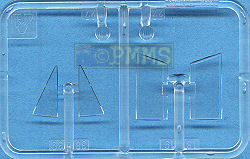
Some areas have been simplified in the design of the kit although there are some weld seams and fine rivet detail included on the hull parts. The large scooped-out areas at the sides of the cab have been all but filled in with a moulded-on mesh panel; this does not appear in all photos but may reflect a design change during production. The mesh cover over the large air intake behind the crew area would also benefit from being replaced by finer mesh. Windscreen frame is moulded as part of the cab front, basic wipers are included though the main and side glassware is way above scale thickness.
Cutting the windscreen frame off and repositioning it in the down position will add some variety, and the front surf plate (part 52A) is also only designed to be fitted up though it is a simple matter to leave off the supporting stays and depict it lowered flat as it would usually be on land.
There has been some attention to detail underneath, with the several drain plugs being depicted though these will not be seem on most completed models.
Access hatch for the engine is also moulded separate for those who want to add an engine from scratch assuming one does not come in an aftermarket set.
The suspension and differentials are quite nicely detailed with all the basic structures including the rear screw for water travel and while the front wheels are not designed to be steerable you could alter the position of the wheels without too many problems.
On the inside the driver's compartment has a separate instrument panel, steering wheel and gear levers but no foot pedals and the rear cargo bay has the floor panels engraved but there is no tread plate pattern included. At the back is a two part winch with again the basic details included but could do with additional detailing plus separate pioneer tools that are fairly basic with moulded on tool brackets.
References are not plentiful alas. There is a Squadron-Signal In-Action on the DUKW (No 2035 ISBN 0-89747-372-8 by Timothy J Kutta) which has several photos of them in action but it is not strong on detail or close-up shots though it does have a couple showing the engine, nor does it have the line drawings following production changes seen in many titles in this series. It does have colour side views but note that the so-called "one of the first production vehicles" has the later-style windscreen and the "all-white British" example is actually pale grey which is the scheme used for many years post-war. Another readily available source is the Concord on US Amtracs and Amphibians at War (No 7032 ISBN 962-361-655-4 by Steve Zaloga and George Balin) though this has far more on the Amtracs it has some good photos of DUKWs in Europe including some better detail shots than those in
the Squadron book.
Best source I have is a long out of print paperback, mv-2 DUKW 2 1/2 ton 6x6 Amphibian by Jeff Woods from ISO Publications in London, England (no ISBN quoted). Published back in 1978 it has a good mix of detail and general photos, extracts from the user manual, some colour schemes, a separate fold-out sheet with an outline plan and cutaway drawing plus detailed measurements and also far more on British vehicles than the other books listed. It you want a good reference I can recommend this though finding a copy may not be easy.
As mentioned there is a full tarpaulin cover or tilt for the cargo area, with the full cover having detail included on both the inside and outside as well as a separate cover for the crew area and some crates, rolls and spare wheels as cargo.
The additional cargo includes some wooden storage boxes that have wood grain texture on both sides of the lid although this is a little over scale it could be toned down during the painting process, plus a single four part jerry can and the two spare wheels which are moulded in one piece as opposed to the six two part wheels for the main DUKW.
Also included is a cal.50 and pedestal mounting to add over the driver's compartment but the cal.50 is rather basic by today's standards and could do with being detailed up using any of the available metal barrel and details sets available.
A length of thread is included to add to the back of the full tarp to represent the securing lines with the instructions having a diagram showing the typical seaman's knot used to secure the thread.
These are the usual exploded view line drawings which are easy enough to follow but as usual careful study of the sequences before any cutting or gluing will reduce any problems along the way.
|
As this is a reissue with some new parts and not a new kit, anyone who already has one of the earlier DUKW kits may not be rushing to buy this one, but if you haven't this is a good excuse as any to pick one up.
It does have a different combination of parts, the ideal would probably be a combination of the two Sprue E parts from this kit and #6446 to give all the options of open cargo compartment, tarpaulin bows or tarpaulin each with or without a machine gun. But modellers looking for a DUKW model at least have the choice of options to choose from.
Recommended.
Click on thumbnails for larger view





Detail images

Close new window to return to review
|
|
|
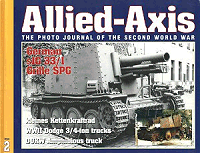 Allied-Axis Allied-AxisThe Photo Journal of the Second World War No.2 Ampersand Publishing. The publishers of MMIR magazine. 96 pages soft cover. |
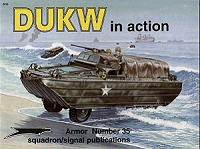 DUKW
in Action DUKW
in ActionSquadron/Signal books #2035 ISBN 0-89747-372-8 |
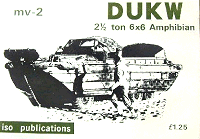 mv-2
DUKW 2 1/2 ton 6x6 Amphibian mv-2
DUKW 2 1/2 ton 6x6 AmphibianJeff Woods ISO Publications |
Thanks to Italeri for the review kit.


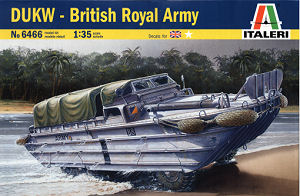
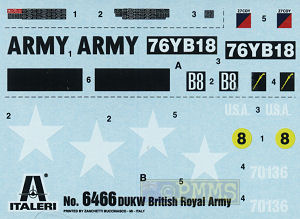
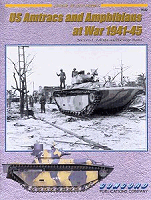 US
Amtracs and Amphibians at War
US
Amtracs and Amphibians at War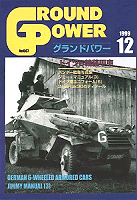 Ground
Power Magazine
Ground
Power Magazine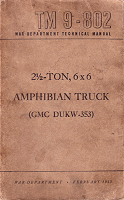 WWII
US War Department
WWII
US War Department